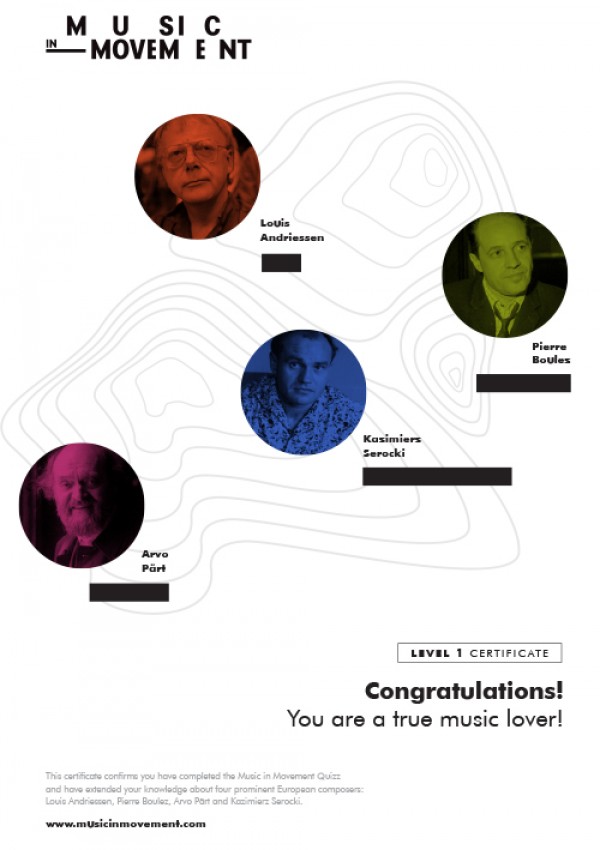MiM quiz – Expert level / Education
Remember, this quiz is not about testing your knowledge about contemporary music. It's all about getting to know the four composers - their music, techniques, but also inspirations and private stories. We invite you to take on this challenge - discover the universe of four personalities and dive in into their music.
Which ones among the four composers wrote music for the youngest performers?
Match each statement with a composer.
Pierre Boulez was once asked to write a piece for an album of modern compositions for piano learners. He did comply with the request and the piece was published on the album, but Une page d’éphéméride is a very demanding composition technically – in any case Boulez himself admitted that he seemed to be unable to write anything simpler.
Kazimierz Serocki’s The Gnomes, a collection of pieces for young pianists, became very popular and was even arranged in various transcriptions for other instruments.
In Louis Andriessen’s Dancing on the Bones, a piece the composer described as a “diabolical scherzo”, a children’s choir sings about what happens to the body after death.
Arvo Pärt’s “children’s” works were issued on the Songs from Childhood album.
Read more about his Music for Children.
20th- and 21st-century composers would often explain their composition techniques and engage in more general theoretical reflections
Many published books or articles; some conducted lectures at universities or courses, sometimes also commented on their works during encounters with non-expert audiences. But there were also those who did not comment on their oeuvres, assuming that music spoke for itself.
He published many books on music written by himself and other composers (especially 20th-century composers). In addition to educational and theoretical work addressed to specialists (composers, musicians, theorists), he devoted a lot of attention to providing comments on contemporary works for concertgoers, including young people.
He lectured in composition at conservatories and courses for young composers. He wrote one book – but he did not devote it to his own oeuvre but to the music of a composer that was artistically particularly close to him.
He did not give interviews and was reluctant to comment on his own oeuvre. He included his reflections on the foundations of his music in several hitherto unpublished lectures.
He did not write about his own music, but in interviews and numerous contributions on various occasions he said a lot about it.
Here are some names of performers important to the four composers for some reason. Link them to the right name.
The conductor Reinbert de Leeuw, together with the Dutch ensembles Schönberg Ensemble and Asko Ensemble (now combined into one Asko/Schönberg Ensemble) performed and premiered many of Louis Andriessen’s works.
Maurizio Pollini is a brilliant interpreter of Pierre Boulez’s piano sonatas, especially No. 2, which he believes is a milestone in the repertoire for the instrument on a par with Beethoven’s sonatas.
Gidon Kremer is a great advocate of Arvo Pärt’s music – at his request the composer wrote Tabula Rasa; Kremer was also the first performer of Fratres in the version for violin and piano.
Les Percussions de Strasbourg premiered Kazimierz Serocki’s percussion sextet Continuum.
In which example is the sound of instruments transformed electronically?
Choose one or more:
Pierre Boulez – …explosante-fixe… for MIDI flute, two flutes, ensemble and electronics (1991–93).
Louis Andriessen – De Tijd for choir and orchestra (1980–81). Louis Andriessen sometimes used electronics, but the sophisticated colours and effects in the piece are achieved without electronics.
Kazimierz Serocki – Pianophonie for piano with electronic transformation of sound and orchestra (1979).
Arvo Pärt – Miserere (1989–92). Arvo Pärt did not use electronics, the reverberation is, of course, entirely natural.
Well done!
We hope you enjoyed the experience!
You can now share & save your MiM certificate!

